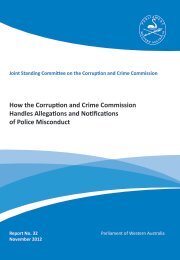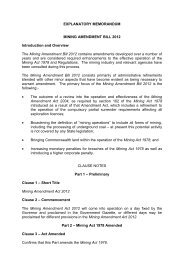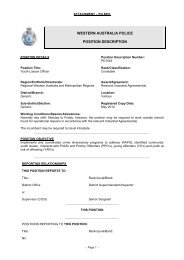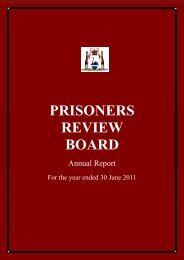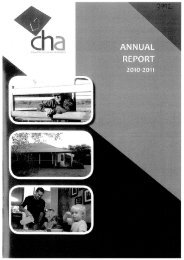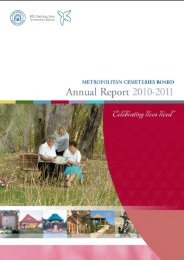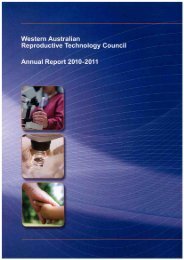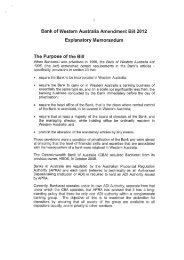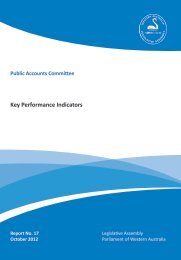Zoological Parks Authority - Parliament of Western Australia - The ...
Zoological Parks Authority - Parliament of Western Australia - The ...
Zoological Parks Authority - Parliament of Western Australia - The ...
You also want an ePaper? Increase the reach of your titles
YUMPU automatically turns print PDFs into web optimized ePapers that Google loves.
<strong>Zoological</strong> <strong>Parks</strong> <strong>Authority</strong> ANNUAL REPORT 2012<br />
Disclosures and Legal Compliance<br />
Financial Statements<br />
<strong>Zoological</strong> <strong>Parks</strong> <strong>Authority</strong><br />
Notes to the Financial Statements for the Year Ended 30 June 2012 continued<br />
35. Financial instruments<br />
(a) Financial risk management objectives and policies<br />
Financial instruments held by the <strong>Authority</strong> are cash and cash equivalents, restricted cash and cash equivalents, loans and receivables, payables and finance leases.<br />
<strong>The</strong> <strong>Authority</strong> has limited exposure to financial risks. <strong>The</strong> <strong>Authority</strong>’s overall risk management program focuses on managing the risks identified below:<br />
Credit risk<br />
Credit risk arises when there is the possibility <strong>of</strong> the <strong>Authority</strong>’s receivables defaulting on their contractual obligations resulting in financial loss to the <strong>Authority</strong>.<br />
<strong>The</strong> maximum exposure to credit risk at the end <strong>of</strong> the reporting period in relation to each class <strong>of</strong> recognised financial assets is the gross carrying amount <strong>of</strong> those<br />
assets inclusive <strong>of</strong> any allowance for impairment as shown in the table at note 35(c) ‘Financial instruments disclosures’ and note 22 ‘Receivables’.<br />
Credit risk associated with the <strong>Authority</strong>’s financial assets is minimal because the main receivable is the amounts receivable for services (holding account). For receivables<br />
other than government, the <strong>Authority</strong> trades only with recognised, creditworthy third parties. Amounts owing by Government agencies are guaranteed and therefore no<br />
credit risk exists in respect <strong>of</strong> those amounts.<br />
<strong>The</strong> <strong>Authority</strong> has policies in place to ensure that sales <strong>of</strong> products and services are made to customers with an appropriate credit history. In addition, receivable<br />
balances are monitored on an ongoing basis with the result that the <strong>Authority</strong>’s exposure to bad debts is minimal. At the end <strong>of</strong> the reporting period there were no<br />
significant concentrations <strong>of</strong> credit risk.<br />
<strong>The</strong> collectability <strong>of</strong> receivables is reviewed on an ongoing basis by individual assessment <strong>of</strong> the debts outstanding. <strong>The</strong> type <strong>of</strong> recovery action is determined by<br />
management and is based on individual assessment <strong>of</strong> debts. Consideration is given to factors such as debt amount, nature <strong>of</strong> debt and past history <strong>of</strong> debtor.<br />
Allowance for impairment <strong>of</strong> financial assets is calculated based on objective evidence such as past experience, and current and expected changes in client credit<br />
ratings. For financial assets that are either past due or impaired, refer to note 35(c) ‘Financial instruments disclosures’.<br />
Liquidity risk<br />
Liquidity risk arises when the <strong>Authority</strong> is unable to meet its financial obligations as they fall due.<br />
<strong>The</strong> <strong>Authority</strong> is exposed to liquidity risk through its trading in the normal course <strong>of</strong> business.<br />
<strong>The</strong> <strong>Authority</strong> has appropriate procedures to manage cash flows including drawdowns <strong>of</strong> appropriations by monitoring forecast cash flows to ensure that sufficient funds<br />
are available to meet its commitments.<br />
Market risk<br />
<strong>The</strong> market risk is the risk that changes in market prices such as foreign exchange rates and interest rates will affect the <strong>Authority</strong>’s income or the value <strong>of</strong> its holdings <strong>of</strong><br />
financial instruments. <strong>The</strong> <strong>Authority</strong> does not trade in foreign currency and is not materially exposed to other price risks.<br />
Other than as detailed in the interest rate sensitivity analysis table at note 35(c), the <strong>Authority</strong> is not exposed to interest rate risk because the majority <strong>of</strong> cash and cash<br />
equivalents and restricted cash are non-interest bearing and it has no borrowings.<br />
<strong>The</strong> interest rate sensitivity is determined by reference to recent trends in interest rate movements and economic forecasts by the Reserve Bank <strong>of</strong> <strong>Australia</strong>.<br />
107



